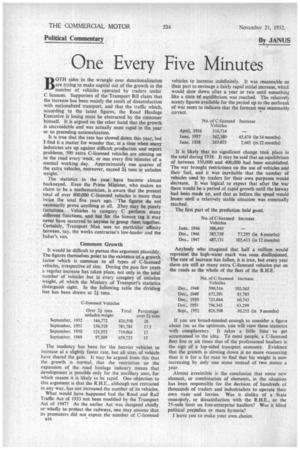One Every Five Minutes
Page 50

If you've noticed an error in this article please click here to report it so we can fix it.
BOTH sides in the wrangle over denationalization are trying to make capital out of the growth in the number of vehicles operated by traders under C licences. Supporters of the Transport Bill claim that the increase has been mainly the result of dissatisfaction with nationalized transport, and that the traffic which, according to the latest figures, the Road Haulage Executive is losing must be abstracted by the customer himself. It is argued on the other hand that the growth is unavoidable and was actually most rapid in the year or so preceding nationalization.
It is true that the rate has slowed down this year, but I find it a matter for wonder that, at a time when many industries are up against difficult production and export problems, 500 extra C-licensed vehicles are coming on to the road every week, or one every five minutes of a normal working day. Approximately one quarter of the extra vehicles, moreover, exceed 24 tons in unladen weight.
The statistics in the case have become almost hackneyed. Even the Prime Minister, who makes no claim to be a mathematician, is aware that the present total of over 800,000 C-licensed vehicles is more than twice the total five years ago. The figures do not necessarily prove anything at all ;They may be purely fortuitous. Vehicles in category C perform many different functions, and but for the licence tag it may never have occurred to anyone to group them together, Certainly, Transport Man sees no particular affinity between, say, the works contractor's low-loader and the baker's van.
Common Growth It would be difficult to pursue this argument plausibly. The figures themselves point to the existence of a growth factor which is common to all types of C-licensed vehicles, irrespective of size. During the past few years a regular increase has taken place, not only in the total number of vehicles but in every category of unladen weight, of which the Ministry of Transport's statistics distinguish eight. In the following table the dividing line has been drawn at 24 tons.
The tendency has been for the heavier vehicles to increase at a slightly faster rate, but all sizes of vehicle have shared the gain. It may be argued from this that the growth is normal, that the restriction on the expansion of the road haulage industry means that development is possible only for the ancillary user, for which reason it is likely to be rapid. One objection to this argument is that the R.H.E., although not restricted in any way, has not increased the number of its vehicles.
What would have happened had the Road and Rail Traffic Act of 1933 not been modified by the Transport Act of 1947? As the earlier Act was designed chiefly or wholly to protect the railways, one may assume that its promoters did not expect the number of C-licensed 1316 vehicles to increase indefinitely. It was reasonable or their part to envisage a fairly rapid initial increase, whict would slow down after a year or two until something like a state of equilibrium was reached. The relativel) scanty figures available for the period up to the outbreak of war seem to indicate that the forecast was seasonably correct.
It is likely that no significant change took place in the total during 1939. It may be.said that an equilibrium of between 350,000 and 400,000 had been established. The war brought restrictions on the use of vehicles and their fuel, and it was inevitable that the number of vehicles used by traders for their own purposes would decrease. It was logical to expect that after the war there would be a period of rapid growth until the leeway had been made up, and that as before the speed would lessen until a relatively stable situation was eventually reached.
The first part of the prediction held good.
Anybody who imagined that half a million would represent the high-water mark was soon disillusioned. The rate of increase has fallen, it is true, but every year there are still as many extra C-licensed vehicles put on the roads as the whole of the fleet of the R.H.E.
If you are broad-minded enough to consider a figure about lm. as the optimum, you will view these statistics with complacency. It takes a little time to get accustomed to the idea. To most people, a C-licensed fleet five or six times that of the professional hauliers is the sign of a lop-sided transport economy. Evidence that the growth is slowing down is no more reassuring than it is for a fat man to find that his weight is now increasing by only one stone instead of two stones a year.
Almost irresistible is the conclusion that some new element, or combination of elements, in the situation has been responsible for the decision of hundreds of thousands of traders and industrialists to operate their own vans and lorries. Was it dislike of a State monopoly, or dissatisfaction with the R.H.E., or the 25-mile limit on free-enterprise hauliers? Was it blind political prejudice or mass hysteria?
I leave you to make your own choice.




















































































